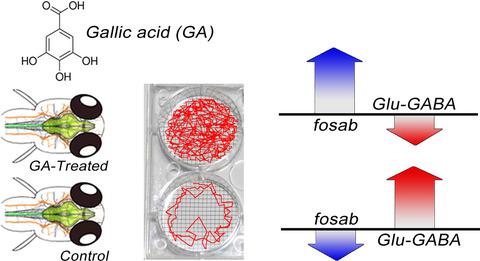当前位置:
X-MOL 学术
›
Eur. J. Neurosci.
›
论文详情
Our official English website, www.x-mol.net, welcomes your
feedback! (Note: you will need to create a separate account there.)
Short‐term exposure to the simple polyphenolic compound gallic acid induces neuronal hyperactivity in zebrafish larvae
European Journal of Neuroscience ( IF 2.7 ) Pub Date : 2020-10-24 , DOI: 10.1111/ejn.15021 Giovanni Annona 1, 2 , Andrea Tarallo 1 , Valeria Nittoli 3 , Ettore Varricchio 1 , Paolo Sordino 2 , Salvatore D'Aniello 2 , Marina Paolucci 1
European Journal of Neuroscience ( IF 2.7 ) Pub Date : 2020-10-24 , DOI: 10.1111/ejn.15021 Giovanni Annona 1, 2 , Andrea Tarallo 1 , Valeria Nittoli 3 , Ettore Varricchio 1 , Paolo Sordino 2 , Salvatore D'Aniello 2 , Marina Paolucci 1
Affiliation

|
A growing body of evidence suggests that the biological effects of polyphenols are not restricted to antioxidant activity, but they exert a wide range of modulatory effects on metabolic pathways, cellular signaling and gene expression. In this study, we tested the minimum safe concentration of gallic acid (GA) in 72 hpf zebrafish larvae in order to evaluate the effects on the central nervous system and the behavioral response. We showed that a short exposure (30 min) induces the depletion of the two main excitatory and inhibitory neurotransmitters, Glu and GABA, respectively, in the larval nervous system. The acute impairment of GABAergic‐glutamatergic balance was paralleled by an increase of the fosab neuronal activity marker in specific brain areas, such as the forebrain, olfactory bulbs, pallial area, ventral midbrain, tegmentum, and the medulla oblongata ventral area. The neuronal excitation was mirrored by the increased cumulative motor response. The inhibition of the olfactory epithelium with brief cadmium exposition suggests a direct involvement of olfaction in the larvae response to GA. Our results demonstrate that a brief exposure to GA induces motoneuronal hyperexcitability in zebrafish. The behavioral response was probably elicited through the activation of an odorous, or chemical, stimulus. The specificity of the activated neuronal territories suggests the involvement of additional signaling pathways. Although the underlying molecular mechanisms remain to be elucidated, our data support the hypothesis that GA acts as an excitatory molecule, capable of inducing a specific nerve response. These results offer a new vision on potential effects of GA.
中文翻译:

短期暴露于简单的多酚化合物没食子酸会引起斑马鱼幼虫的神经元活动亢进
越来越多的证据表明,多酚的生物学作用不仅限于抗氧化活性,而且对代谢途径,细胞信号传导和基因表达也具有广泛的调节作用。在这项研究中,我们测试了72 hpf斑马鱼幼虫中的没食子酸(GA)的最低安全浓度,以评估其对中枢神经系统和行为反应的影响。我们表明,短暂的暴露(30分钟)会导致幼虫神经系统中两种主要的兴奋性和抑制性神经递质Glu和GABA的消耗。GABA能-谷氨酸能平衡的急性损害与fosab的增加并存特定大脑区域(例如,前脑,嗅球,丘脑区,腹中脑,睑板和延髓腹侧区)的神经元活动标记。增加的累积运动反应反映了神经元兴奋。短暂的镉暴露对嗅觉上皮的抑制表明嗅觉直接参与了幼虫对GA的反应。我们的结果表明,短暂暴露于GA会引起斑马鱼的动神经元过度兴奋性。行为反应可能是通过气味或化学刺激的激活而引起的。活化的神经元区域的特异性表明其他信号通路的参与。尽管潜在的分子机制尚待阐明,我们的数据支持以下假设:GA是一种兴奋分子,能够诱导特定的神经反应。这些结果为GA的潜在影响提供了新的视野。
更新日期:2020-10-24
中文翻译:

短期暴露于简单的多酚化合物没食子酸会引起斑马鱼幼虫的神经元活动亢进
越来越多的证据表明,多酚的生物学作用不仅限于抗氧化活性,而且对代谢途径,细胞信号传导和基因表达也具有广泛的调节作用。在这项研究中,我们测试了72 hpf斑马鱼幼虫中的没食子酸(GA)的最低安全浓度,以评估其对中枢神经系统和行为反应的影响。我们表明,短暂的暴露(30分钟)会导致幼虫神经系统中两种主要的兴奋性和抑制性神经递质Glu和GABA的消耗。GABA能-谷氨酸能平衡的急性损害与fosab的增加并存特定大脑区域(例如,前脑,嗅球,丘脑区,腹中脑,睑板和延髓腹侧区)的神经元活动标记。增加的累积运动反应反映了神经元兴奋。短暂的镉暴露对嗅觉上皮的抑制表明嗅觉直接参与了幼虫对GA的反应。我们的结果表明,短暂暴露于GA会引起斑马鱼的动神经元过度兴奋性。行为反应可能是通过气味或化学刺激的激活而引起的。活化的神经元区域的特异性表明其他信号通路的参与。尽管潜在的分子机制尚待阐明,我们的数据支持以下假设:GA是一种兴奋分子,能够诱导特定的神经反应。这些结果为GA的潜在影响提供了新的视野。









































 京公网安备 11010802027423号
京公网安备 11010802027423号